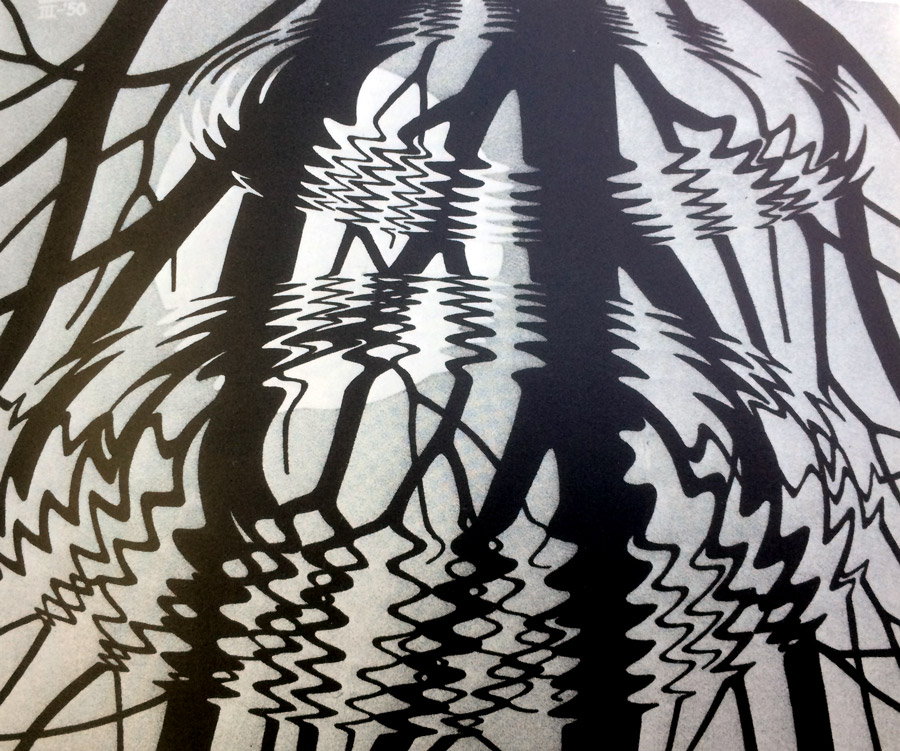
Now that I’m borderline obsessed with geometric design after my course at the Prince’s School of Traditional Arts, it’s clear to me that geometry has not only always underpinned my work but underpins the way the world works.
I’ve come across lots of geometric art recently but I wanted to start by posting work from one of the heavyweights. Some of MC Escher’s work is so ubiquitous that is easy to forget how rigorous and impressive it is. He was massively influenced by Islamic art from his 3 month visit to the Alhambra Palace in Spain, one of the pinnacles of Islamic geometric art. Through revisiting his work, I’ve discovered some pieces I probably had seen but had forgotten; not only the geometric work but also a lot of more organic images. Even these images display his interest in maths, just in a less obvious way. Similarly to the Alhambra Palace which combines formal gardens and a building dripping with geometric design, his combination of mathematically inspired pattern and organic images demonstrates the beauty of natural form. This resonated with me because geometry and maths are the language of nature and nature is full of imperfect examples of geometric rules and structures. Additionally, he is a masterful relief printer, often using woodcut and lino.




Moving from space to time, music is traditionally seen as one of the ‘quadrivium’ of subjects; arithmetic (number), geometry (number in space), music (number in time) and astronomy (number in space and time). Linking with Escher in a slightly obtuse way, I wanted to make mention of one of the best metal bands currently operating and a perfect example of the idea of number in time, Meshuggah. Aesthetically very much a metal band but conceptually at the outer reaches of sonic exploration, the fractalline overlapping of different rhythmic structures and awkward harmonics in their music remind me of the overlapping fields of shape and colour in Islamic art and in Escher’s work. The experience of both is similar too; an overwhelming immersion in structures that are hard to decipher but lock into the essence of being. They’re playing in London in December; there’s no better way to experience their unique approach and see one of the most talented drummers on the planet, Tomas Haake.


Comparing the most innovative and original European musicians on the planet (the most innovative after contemporary classical composers; for example Beat Furrer) to Islamic art, is like comparing a space shuttle to a camel. The West is the only culture that evolves in its Art; every other culture’s music and Art is the same as it was hundreds or thousands of years ago. Non-Western peoples either practice their indigenous, traditional Art, or they adopt a Western influenced style. I don’t know what type of person you are, but if you call me a xenophobe for stating clear, obvious facts, then I ask you to direct your accusations of xenophobia towards the Middle East or Africa, or Asia, or Hispaniola or any other place where people are everything Europeans are constantly accused of being, simply because they’re achievements are so great, and Cultural Marxists bully people into thinking they are supposed to feel guilty and apologize for their intellectual prowess.
Thanks for the comment. I am only drawing a comparison between their use of mathematics as an underlying structure, something I am also inspired by. They both use completely different tools for different ends at different times, yet the overall feeling of dense rhythmic immersion is similar for both because of the use of mathematical structures. Beyond that you’re entitled to your opinion, whether I disagree or not. At least you like Meshuggah, we can agree wholeheartedly on that.
The first drawing, which I don’t remember too, looks to me as a picture of the Andalucia. It’s interesting how does it called.
Came for the Islamic geometry, stayed for Meshuggah.
Hah.. yes! \m/_ _\m/